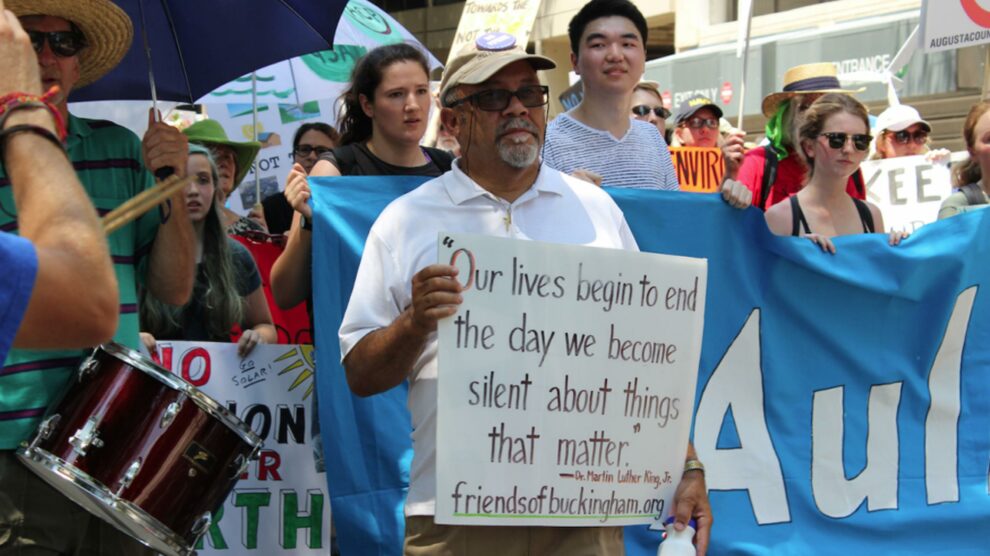Can a Just Transition Change Appalachia’s Balance of Power?
By Morgan Hickory and Lydia Patton
Volume 23, number 2, People’s Green New Deal

Encuentre una traducción de este artículo en español en nuestro sitio web.
Mining and Nurses
“Biggest thing we got around here is that everything is based off coal. I’m not down on coal, like I said, I’m grateful for it, I love it, and whoever else still wants to do it, more power to you. I’ll back you 100 percent. But we have to find something else around here to support our economy. Mining and nurses the only two things you got. If you don’t put some other type of industrial occupation around here, something that’s not based on coal, then our economy is going to be destroyed. There’s literally nothing left for you to do. Like I said, it’s fast food, making minimum wage, mining, or nursing.”
David Lee Brett, Jr., former coal miner in Harlan County, KY
A new generation of progressive thinkers, from slightly left-of-center Democrats to committed socialists, is proposing federal legislation for a sweeping economic transition away from fossil fuels. Termed the Green New Deal (GND), this proposal promises to phase fossil fuel industries out of existence and introduce well-paid alternatives for workers in these industries. Any federal project that begins as a policy idea, even if it is enacted by Congress, will encounter challenges on the ground. This is especially true in places like Appalachia, where highly localized systems of power, in place for decades or even centuries, funnel resources into channels controlled by the existing ruling class. Federal injections of money are a periodic occurrence in Central Appalachia, whether distributed through New Deal job creation and infrastructure programs in the 1930s or through humanitarian aid efforts initiated by the War on Poverty in the 1960s.1 Local apex families and entrenched government systems have adapted to take advantage of and benefit from extractive industries such coal. As such, the GND risks floundering in Appalachia if robust local knowledge about its people and politics is not built into the conception and execution of a People’s Green New Deal (PGND).
Just Transition or Just Another Transition?
Two forces have shaped the coalfields of Appalachia: labor and outside investment. The “mine wars” of the 1920s and 1930s saw organized labor in the region fight back after years of oppression. For instance, the unions were able to establish power through actions like the Battle of Blair Mountain and Bloody Harlan. However, jobs dried up in the 1990s as workers were gradually replaced by mechanization.
Since many coal towns and regions were established around mining activity, the ups and downs of the industry contribute to their economic precarity. Throughout the decades in Appalachia, advocates in DC have proposed policies to alleviate poverty and to train and “elevate” the population: from Franklin Delano Roosevelt’s original New Deal and Lyndon B. Johnson’s War on Poverty to the Appalachian Regional Commission (ARC) and now, the “Just Transition” movement.
Poverty in the region stems in part from broad form deeds, legal documents that created “two separate estates on a single piece of land by horizontally severing the mineral estate from the surface estate.”2 These estate owners stripped the land of its usefulness, returned it ravaged to the locals, then shuttled their profits out of state.3 A portion of these profits would be sent back in the form of social programs and charities, but carefully, so that poor people were never put in charge of the funds delivered. There is little practical difference, to a local, between an investor who buys a coal mine and takes the profit out of state and an investor-backed social enterprise intended by the government to lift locals out of poverty. In both cases, the investors hold the money just out of reach, circulating in elite channels inaccessible to the people.
Many policy initiatives that were intended to be progressive were co-opted by local governments. Appalachian governors and mayors protested many progressive Great Society reforms, especially those that disrupted the flow of capital.4 The Great Society resulted in the creation of an entity called the Appalachian Regional Commission. Although this entity purportedly provides economic development grants to Appalachian counties, these grants have fallen time and again into the hands of the coalitions of businesses, nonprofits, universities, and foundations administering them. Poor people have little say in where this money goes, and the reform projects are not necessarily in the interest of the rural poor.
The development model of the Appalachian Regional Commission centers urban areas, designating them as “growth areas.” Initially, all roads funded through ARC grants were constructed deliberately to funnel rural workers into cities, rather than to connect rural people to one another. This strategy of depopulation discouraged any real investment in the economic vitality of rural places, leaving those who were left behind—the elderly, the vulnerable, the addicted, the desperately poor, and those otherwise unable to work—further away from stability.
To many living in the Appalachian coalfields and working on environmental issues, the Green New Deal is a familiar type of idea, similar to an ideological framework called “Just Transition.” This framework centers workers’ livelihoods and rights in undoing the damage done by the fossil fuel industry. One origin story for this framework ascribes it to the “superfund for workers,” proposed by labor leaders Tony Mazzocchi and Les Leopold, which “would provide financial support and an opportunity for higher education for workers displaced by environmental protection policies.”5
The movement for a just transition is broad, encompassing potentially inconsistent goals. Some in the labor movement have spoken up against its radical environmentalist and anti-capitalist tendencies. Furthermore, without strong unions, those hired into jobs created by transition projects may risk trading good jobs in coal for unstable contract positions that may not pay living wages. Rich Trumka, president of the AFL-CIO, dismissed the just transition framework as a “fancy funeral,” arguing that, even if the jobs did come through, workers who opted out of retraining for any reason would be left behind.6 These jobs are therefore difficult to replace. Despite the hardship of coal mining, many miners make a good wage, well above the state median, and receive family benefits, though these have dwindled in recent years. The work is regarded as dignified and noble. Many workers do not want to hunch over computers learning how to code, training for jobs that hardly exist.
It is a popular perception that extractive industries are the best hope for a region without other options, a perception that leads to overlooking viable alternatives. In rural Appalachia, for instance, it is not always easy to find a trained plumber, electrician or welder when you need one. Small farming could be key to a PGND and to the region’s ability to support its people, despite being hit by “land development, mechanization… and the growth of agribusiness.”7
It is worth considering what demands might allow not just for survival, but the continued dignity of these essential laborers—whether a federal jobs guarantee, a universal basic income, or access to training and union apprenticeships. Despite narratives that cast Appalachians as ignorant of political realities, the tensions between environmentalism and labor are known and lived here. The lack of realized alternatives to jobs in extraction looms large. There are concrete examples of transition projects, such as the Black Mesa solar array in the Navajo Nation, but nothing of that scale currently exists in Appalachia. Coalfield Development is growing, but does not yet employ Appalachians at coal industry scale.8 If a PGND were to solve this problem, it could revolutionize the region—but there is rugged terrain to navigate and historical injustices to set right.
Although many families in the region have struggled for a long time, the most marginalized people in Appalachia are people of color—Black and Indigenous Appalachians whose land and labor were stolen to enrich white settlers and who have been displaced and impoverished by the extraction industries. Recognizing this and moving toward a future that places these communities at the center of the movement will not be popular everywhere—but it is right.
A movement powerful enough to set a PGND in place must challenge entrenched local and state power and instead build power of the people. But it must also implement solid, durable alternatives: not only allocating funds from DC, but working with the people in the region to make sure that funds are invested properly, that they get to the people they are supposed to help, and that local political processes are no longer captured by power brokers. Without these in place, locals will continue to distrust government initiatives, and for good reason.
Appalachia’s Power Brokers
Power in this region is held through a fragmented but far-reaching quilt of absentee land ownership. A 1980s land study conducted at Vanderbilt University showed an ugly truth: nearly 100 percent of Appalachian mineral rights and 90 percent of surface rights in the coalfield counties they surveyed were owned by absentee landholders residing in far-flung areas, from Texas, Florida, and New York to London and Beijing.9 Appalachian poverty thus fundamentally stems from the area’s mineral wealth being literally sold out from under its residents’ feet, with coal miners taking only an infinitesimal fraction of that wealth home to their families. However, this has been ignored by large-scale anti-poverty efforts, which at worst have protected and at best have ignored the coal industry’s history of exploitation.
The most economically marginalized people in the Appalachian coalfields, who would benefit the most from the Green New Deal, have the least pull in financial allocations. Coal stronghold Letcher County, in Eastern Kentucky, is slightly wealthier than the average county in the region. Its voting rate hovers somewhere around 20 percent, per capita income is under $20,000 per year, poverty rate is roughly 30 percent, and bachelor’s degree attainment is 11 percent.10 Despite years of anti-poverty programs, the statistics are daunting. According to a recent report, “income for the wealthiest one percent of earners in Kentucky was more than $719,012 in 2015, compared to an average [household] income of almost $39,990 for all other Kentuckians.”11This inequality is growing. In Kentucky, a “report from the Economic Policy Institute shows from 2009 to 2015 the top one percent[‘s] income grew 23.2 percent while everyone else’s income grew only 7.2 percent.”12
Even with supposedly progressive aims, anti-poverty programs tend to consolidate local power structures. Most ordinary people are not attending city council or fiscal court meetings, nor applying for or receiving grants. For example, the Abandoned Mine Lands (AML), within the Bureau of Land Management (in turn, within the US Department of the Interior), was intended as reparations money for the destruction of the environment to supplement the loss of local revenue through a severance tax.13 Though some money was returned to coal counties through taxes on coal, taxes have dried up with the coal supply, and the people who were enriched by the coal industry retain their wealth and immense local power. Ironically, they are now best placed to apply for AML funding.14
AML funding was intended to reduce the harm caused by abandoned mine seepage and ground disturbance through ecological remediation. But the imperative of job creation at any cost is baked into the AML process: when reporting on grant activity, federal and local politicians must show that they have contributed to the economic development of the region. Many projects overlook the aim of ecological remediation in favor of the creation of (often precarious) jobs, which tend to center around projects extending the power of wealthy coal families in the region.
For instance, in Letcher County, a prominent local family, the Childers, owns the Childers Oil Company and the Double Kwik gas station chain. An heiress of of the Childers family is is currently prominent on the Tourism Board of Letcher County, which, under her direction, received in 2019 an AML grant of $3.5 million to start a sport shooting and resort park.15
In November 2008, oil sludge “leaked from Childers’ property into the North Fork of the Kentucky River upstream from Whitesburg.”16 In February 2009, the same happened with diesel fuel, “forcing the city water plant to shut down and leave thousands of residents without clean water for days.” Childers Oil was cited by the state but denied wrongdoing; Childers’ daughterMissy Matthews was then Vice President of the company. That makes her an unlikely choice to administer funds for a major environmental reclamation project. But their daughter’sMatthews’s place at the head of an AML project makes sense if you understand how environmental reclamation work is done here. To Appalachia’s power brokers, repairing the ecological damage done by the coal industry comes as a distant third to what is valued most: economic development and job creation.
The Green New Deal will have to change that calculus. That will require shifting local power structures and countering entrenched beliefs.
Conclusion
A Green New Deal that truly shifts the current structures of power is vital to the survival of this region. A People’s Green New Deal answers directly to and organizes poor people to gain power in their communities. A People’s Green New Deal improves vital infrastructure—not just roads, but sanitation, water, and public broadband for all—without asking that the money pass through private or wealthy hands first. It would provide electric and water utility boards staffed by ratepayers and implement voter registration at 100 percent of the eligible population. Critically, it would provide a pathway to a dignified and financially stable life for people who may not want, be able to perform, or be able to move for whatever green jobs become available: people who want to live in the place they call home.
Green infrastructure is not always liberatory. When implemented with a capitalistic mindset to enrich a company rather than to serve the people, these projects result in land and power grabs. If the Green New Deal is to truly change anything, the theft of land and resources cannot continue, and these projects must happen through a public process that replaces the old system of extractive industry handshakes. Failing to do so will bind us to the dynamic flows of capital and job creation that exploit workers, destroy land, and concentrate resources. In other words: new boss, same as the old one.
- Ronald Eller, Uneven Ground (The University Press of Kentucky, 2008).
- Stephanie M. Lang, “Titles Must Be Perfect: The Broad Form Deed, Politics, and Landownership in Eastern Kentucky at the Turn of the Twentieth Century,” Register of the Kentucky Historical Society 113, no. 1 (2015): 27-57, https://muse.jhu.edu/article/576404.
- Priyanka Srinivasan, “Appalachia’s Fickle Friend,” Jacobin, December 5, 2017, https://jacobinmag.com/2017/12/appalachia-friends-of-coal-mining-industry-jobs-environmental-just-transition.
- Eller, Uneven Ground, 129.
- Labor Network for Sustainability, “Just Transition–Just What Is It?,” accessed June 26, 2020, http://www.labor4sustainability.org/uncategorized/just-transition-just-what-is-it/.
- “Just Transition–Just What Is It?”
- Anne Chesky, “Can Agritourism Save the Family Farm in Appalachia?” Journal of Appalachian Studies 15, no. 1/2 (2009), www.jstor.org/stable/41446820.
- Coalfield Development, 2019, accessed June 26, 2020, https://coalfield-development.org/.
- Appalachian Land Ownership Task Force, Who Owns Appalachia? (University Press of Kentucky, 1983).
- Data retrieved: censusreporter.org.
- Becca Schimmel, “Report Examines Income Inequality In Kentucky,” WVXU, July 23, 2018, https://www.wvxu.org/post/report-examines-income-inequality-kentucky#stream/0.
- Schimmel, “Income Inequality.”
- “Reclaiming Abandoned Land Mines,” Office of Surface Mining Reclamation and Enforcement, accessed June 26, 2020, https://www.osmre.gov/programs/aml.shtm.
- Sam Bell, “Life after Coal,” The New Internationalist, April 9, 2019, https://newint.org/features/2019/04/09/life-after-coal.
- Kevin Day, “Letcher County’s new Thunder Mountain Resort to be located at Marlowe,” 103.9 WXKQ, September 7, 2019; Lacey Roberts, “$3.5 million grant will build sports-gaming resort in Letcher County,” WYMT, September 10, 2019.
- Dori Hjalmarson and Bill Estep, “Don Childers,” Lexington Herald-Leader, April 5, 2009, https://www.kentucky.com/news/state/kentucky/article43995747.html#storylink=cpy; CSNews Online, “Childers Oil Co. Blamed For Polluting Water Source,” April 7, 2009, https://csnews.com/childers-oil-co-blamed-polluting-water-source.





